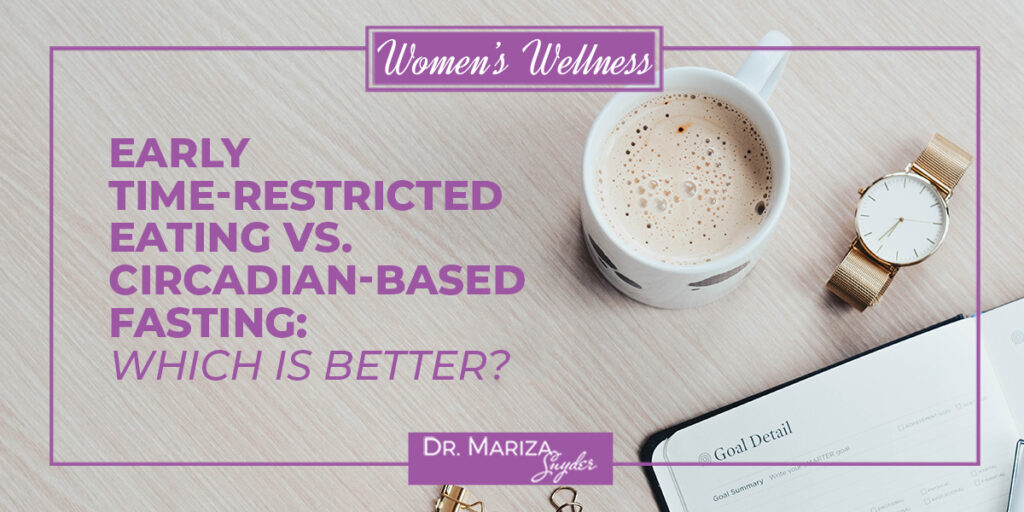
Want to know two of my favorite types of intermittent fasting?
Let’s dive into circadian-based intermittent fasting and early time-restricted eating.
Although very closely related, early time-restricted eating is just slightly different from circadian-based intermittent fasting.
Knowing the nuanced differences between these two types of intermittent fasting will help you choose the one that suits your lifestyle the best!
To start, circadian-based intermittent fasting is when you fast in alignment with your circadian rhythm– or your sleep-wake cycle. The goal is to eat while the sun is out, and fast while the sun is down.
Early time-restricted eating still follows this idea, but it just moves your eating window to earlier in the day so you avoid eating later in the evening.
Seems pretty simple, right?
Although these types of intermittent fasting are similar, I’m giving you a detailed comparison of the two– so you know exactly how to give them a shot!
And remember, one fasting method isn’t necessarily better than the other– the best option for you depends on your own unique health situation.
Circadian-Based vs. Early Time-Restricted Eating
To get a clear understanding of the difference between these two types of intermittent fasting, let’s first break down what each of them is.
Circadian-Based Intermittent Fasting Method
As mentioned, the circadian-based intermittent fasting schedule is aligned with your circadian rhythm. It involves varying fasting and eating windows depending on the time of day the sun rises and sets.
The sunrise-to-sunset schedule varies from day to day as you know. But the goal is to stick to your general circadian rhythm so you can help your body better metabolize your food.
Factors in the body react to the natural light of the day, such as hormones like cortisol and melatonin. Your body’s biology shifts on a cellular level when the sun goes down, so eating in tune with this cycle optimizes your health.
Meal timing for circadian-based intermittent fasting is flexible, as most days the sun is up for 8+ hours. Your decision about when to eat meals can fall at any point in this window. So it’s easy to adjust your meal timing to match your circadian rhythm.
Here’s an example:
If the sun rises at 6:30 am and sets at 9 pm…
- Have breakfast in the morning between 8 am and 9 am
- Eat additional food throughout the day on your own timeline
- Eat your final meal sometime before 8 pm
Circadian-based intermittent fasting is a great place to start with intermittent fasting because your eating window is quite large compared to some other types of intermittent fasting.
Early Time-Restricted Eating / Reverse Fasting Method
Early time-restricted eating, also known as reverse fasting is a specific type of intermittent fasting. It’s a subset of circadian-based intermittent fasting as it follows the same main principle of fasting while the sun is down.
However, it focuses on limiting eating to earlier hours of the day, eating your last meal in the early evening. The goal is to be consistent with the same fasting and eating windows every day.
Meal timing for early time-restricted eating should remain the same from day to day to see and feel the best results. So it’s a bit less flexible than just circadian-based intermittent fasting because your eating window may be smaller.
Here’s an example:
If the sun rises at 6:30 am and sets at 9 pm…
- Wake up early and have breakfast between 7 and 8 am
- Eat a large lunch with protein mid-day
- Have dinner between 4 and 5 pm– with ZERO additional food afterward
The goal of early time-restricted eating is to get consistent with eating larger meals earlier in the day, and having your last meal in the early afternoon so you can give your body plenty of time to digest before bed.
This small but important detail has profound metabolic and hormonal implications!
Key Benefits of These Types of Intermittent Fasting
Intermittent fasting has become so wildly popular because of its weight loss and metabolic benefits. Here are a few key benefits of these specific types of intermittent fasting.
Improve Insulin Sensitivity
Circadian-based fasting may leverage natural insulin sensitivity variations. Eating later in the evening after the sun is down can dysregulate your blood sugar levels. So aligning meal times with your circadian rhythm promotes better blood sugar control.
Boost Your Metabolism and Energy
Staying consistent with a fasting method also has numerous metabolic benefits. When eating with your circadian rhythm, your body is ready to burn calories from your food rather than storing it as fat. This boosts your metabolism, setting you up for results.
Prevent Chronic Disease and Illness
Eating with your circadian rhythm can prevent inflammation, and may even enhance cardiovascular health. Staying consistent with one of these types of fasting methods may reduce your risk of chronic diseases like diabetes, obesity, and even some cancers.
Lose Weight (Especially Belly Fat!)
Both circadian-based intermittent fasting and early time-restricted eating allow your body to optimize natural fat-burning mechanisms. So consistently stick to one of these types of intermittent fasting, and start to shed those extra pounds!
How to Add Early-Time Restricted Eating or Circadian-Based Intermittent Fasting To Your Routine
Implementing intermittent fasting can be easier than you may think.
Both circadian-based intermittent fasting and early time-restricted eating offer simplicity because of the fixed eating window. When you’re consistent with your meal timing from day to day, it provides you with a sense of routine.
Now, deciding between these two types of intermittent fasting takes an individualized approach. The choice depends on your preferences and lifestyle.
Consider your daily schedule and metabolic goals to help you choose which type of intermittent fasting method is right for you.
To be effective with intermittent fasting for optimal results, consider these 3 recommendations when starting out– whether following the circadian-based or early time-restricted eating method.
#1 – Eat a Metabolically-Healthy and Balanced Breakfast
Make sure to break your fast in the morning with a balanced breakfast! This means incorporating protein, fiber, and healthy fats into your first meal of the morning.
A balanced meal to start off your eating window is optimal for your metabolism.
#2 – Keep Meals High in Protein, Healthy Fats, and Fiber—and Low in Added Sugar
For the best results, make sure you’re following a protein-rich diet, and avoiding excess sugar! This is essential for helping prevent cravings throughout your day, but especially in the evening.
Eating a protein, fat, and fiber-rich last meal of the day will keep you full longer, helping you stick to your fast until morning.
#3 – Avoid Late-Night Snacking
This is off-limits if you’re sticking to either of these fasting methods! After dinner– do NOT go searching your fridge or pantry for one last snack before bed.
Late-night snacking throws your blood sugars out of whack and keeps you from getting the restful sleep you need. So clear out those cabinets and avoid the urge to eat after dinner!
The Bottom Line
Let’s quickly recap…
Circadian-based intermittent fasting aligns meal timing with your circadian rhythm, offering flexibility.
Early time-restricted eating involves a consistent, daily eating window in the earlier hours, with no food later in the evening.
Both of these intermittent fasting methods offer metabolic benefits, but your choice depends on your individual lifestyle and preferences.
So it’s now up to you to explore both types of intermittent fasting and choose one that best fits your unique needs.
I can’t wait for you to become the CEO of your health and metabolism!
If you’re looking for more tips on intermittent fasting, and other methods to kick-start your metabolism


No comments yet.